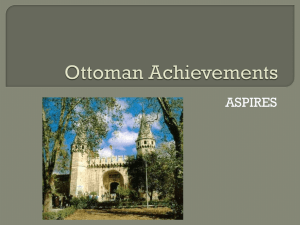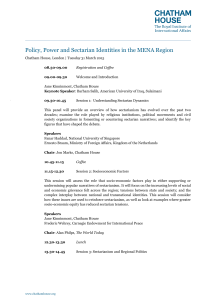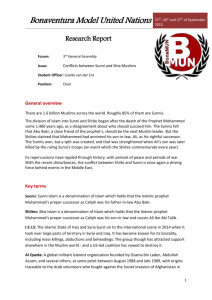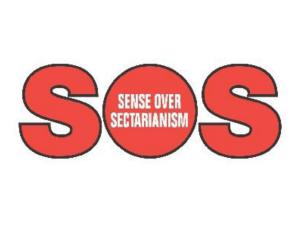Here - Muswell Hill Synagogue
advertisement
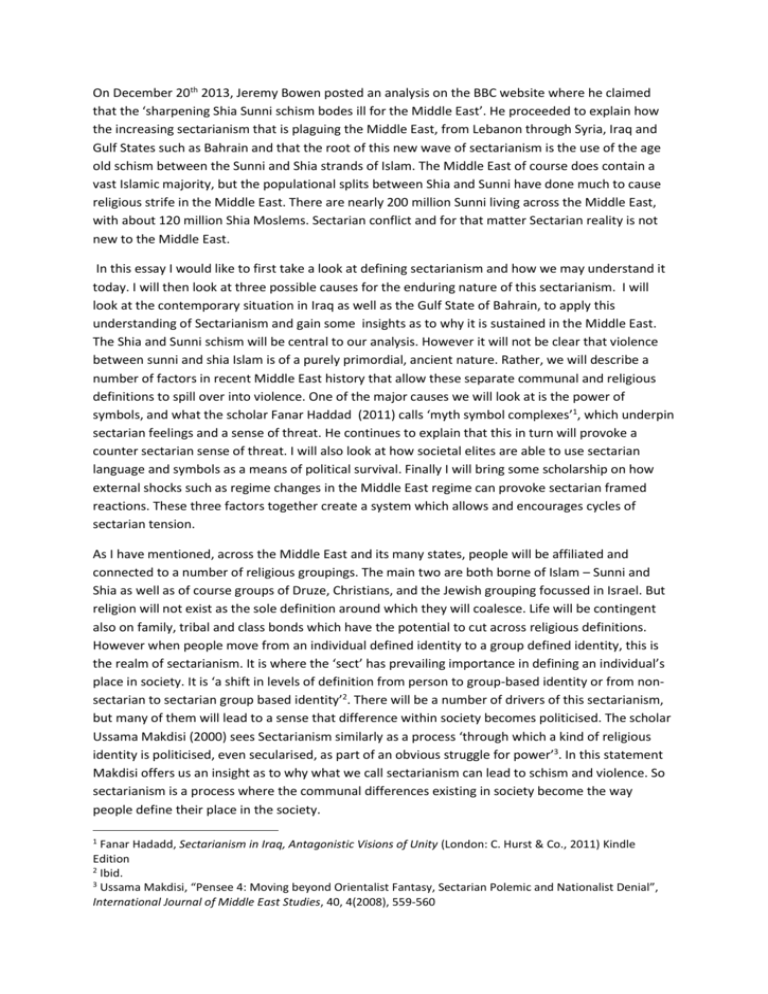
On December 20th 2013, Jeremy Bowen posted an analysis on the BBC website where he claimed that the ‘sharpening Shia Sunni schism bodes ill for the Middle East’. He proceeded to explain how the increasing sectarianism that is plaguing the Middle East, from Lebanon through Syria, Iraq and Gulf States such as Bahrain and that the root of this new wave of sectarianism is the use of the age old schism between the Sunni and Shia strands of Islam. The Middle East of course does contain a vast Islamic majority, but the populational splits between Shia and Sunni have done much to cause religious strife in the Middle East. There are nearly 200 million Sunni living across the Middle East, with about 120 million Shia Moslems. Sectarian conflict and for that matter Sectarian reality is not new to the Middle East. In this essay I would like to first take a look at defining sectarianism and how we may understand it today. I will then look at three possible causes for the enduring nature of this sectarianism. I will look at the contemporary situation in Iraq as well as the Gulf State of Bahrain, to apply this understanding of Sectarianism and gain some insights as to why it is sustained in the Middle East. The Shia and Sunni schism will be central to our analysis. However it will not be clear that violence between sunni and shia Islam is of a purely primordial, ancient nature. Rather, we will describe a number of factors in recent Middle East history that allow these separate communal and religious definitions to spill over into violence. One of the major causes we will look at is the power of symbols, and what the scholar Fanar Haddad (2011) calls ‘myth symbol complexes’1, which underpin sectarian feelings and a sense of threat. He continues to explain that this in turn will provoke a counter sectarian sense of threat. I will also look at how societal elites are able to use sectarian language and symbols as a means of political survival. Finally I will bring some scholarship on how external shocks such as regime changes in the Middle East regime can provoke sectarian framed reactions. These three factors together create a system which allows and encourages cycles of sectarian tension. As I have mentioned, across the Middle East and its many states, people will be affiliated and connected to a number of religious groupings. The main two are both borne of Islam – Sunni and Shia as well as of course groups of Druze, Christians, and the Jewish grouping focussed in Israel. But religion will not exist as the sole definition around which they will coalesce. Life will be contingent also on family, tribal and class bonds which have the potential to cut across religious definitions. However when people move from an individual defined identity to a group defined identity, this is the realm of sectarianism. It is where the ‘sect’ has prevailing importance in defining an individual’s place in society. It is ‘a shift in levels of definition from person to group-based identity or from nonsectarian to sectarian group based identity’2. There will be a number of drivers of this sectarianism, but many of them will lead to a sense that difference within society becomes politicised. The scholar Ussama Makdisi (2000) sees Sectarianism similarly as a process ‘through which a kind of religious identity is politicised, even secularised, as part of an obvious struggle for power’3. In this statement Makdisi offers us an insight as to why what we call sectarianism can lead to schism and violence. So sectarianism is a process where the communal differences existing in society become the way people define their place in the society. 1 Fanar Hadadd, Sectarianism in Iraq, Antagonistic Visions of Unity (London: C. Hurst & Co., 2011) Kindle Edition 2 Ibid. 3 Ussama Makdisi, “Pensee 4: Moving beyond Orientalist Fantasy, Sectarian Polemic and Nationalist Denial”, International Journal of Middle East Studies, 40, 4(2008), 559-560 As to the question from where these sectarian loyalties derive, there is a large amount of scholarship which mirrors the scholarly debates on identity and specifically national and ethnic identity. We are aware within this scholarship of those who consider ethnic identity as primordial and ‘given’. A primordial approach would look at sectarian definition as endemic and in many ways inevitable. On the other hand, Constructivist approaches would look at sectarianism as something modern and constructed. Both these approaches do have their problems. As Larkin (2012) writes: ‘primordialism tends to reify traditional bonds, leaving little space for human agency or historic change; constructionism often underplays the persistence of kinship loyalties...’4 Primordialist approaches clearly are more difficult to apply from an academic historical perspective. But the modernist approach in its different forms, looks at ethnic and national difference as coming from external sources only. As a result of the more extreme and closed forms of modernist nationalist theory, the scholar Anthony Smith developed his theory of Ethnosymbolism. Here Smith admits that the onset of nations is a modern phenomena, however he claims that the roots of nations are in the existence of ethnies, pre modern ethnic cultural communities. This then encourages us to take a longer, historical view of a nation, something that Smith calls ‘long duree’5. Furthermore, and more pertinent for our analysis of sectarianism, the past of a nation, its ethnohistory, impacts on the present through what John Armstrong calls a ‘myth symbol complex’6. This is central to EthnoSymbolists such as Armstrong and Smith, and is a collection of ‘memories, myths, values and traditions’7 which are used to create and define the modern nation. So firstly, Smith is defining a difference between Ethnic or religious identity on the one hand, and national identity on the other. Secondly, he is explaining that old, pre modern ethnic symbols answer the question of why nations persist to be. In Smith’s opinion, EthnoSymbolism renders primordialist approaches unnecessary ‘while addressing the fundamental problem of the emotional power and hold of nationalism and its capacity for inspiring mass devotion and self sacrifice’. Myth Symbol Complex and Sectarianism in Iraq It is possible to look at Sectarianism as being fuelled by the existence of ‘myth symbol complexes’. Stuart Kaufman (2001) for instance explains that: ‘The core of the ethnic identity is the ‘myth-symbol complex’ – the combination of myths, memories, values and symbols that defines not only who is a member of the group but what it means to be a member’8 4 Craig Larkin, Memory and Conflict in Lebanon, Remembering and forgetting the past (London and New York: Routledge, 2012) 43 5 Anthony Smith, Nationalism (Polity Press, 2010) 66 6 John Armstrong (1982), Nations before Nationalism. (Chapel Hill : University of North Carolina Press, 1982) Chapter 1 7 Anthony Smith, The Nation in History: Historiographical Debates about Ethnicity and Nationalism. (Hanover: Brandeis University Press/Historical Society of Israel, 2000) , 66 8 Stuart J. Kaufman, Modern Hatreds, The Symbolic Politics of Ethnic War (Cornell University Press 2001), 25 Kaufman uses the idea of the myth-symbol complex to bridge the primordialist and instrumentalist schools of nationalism theory to create a synthesis where national identities are indeed created, however they are seen as evolving from earlier pre modern cultural kinships. Group loyalty and kinship is crucial to Kaufman’s synthesis which mirrors the Ethnohistorical approach mentioned earlier of Anthony Smith. This group loyalty coalesces around a set of emotional symbols and values which are invested with great emotional and psychological import. What is more, within this web of historical myths and symbols can exist a sense of prejudice for the other and desire to dominate the other A kinship group may feel a fear of being targeted or exterminated. This will lead to possibilities of group aggression and violence. Quoting the work of Crawford Young, Kaufman states that: ‘...the atmosphere of hostility threat is likely to increase group solidarity, encourage the groups to perceive events in ethnic terms, and promote misperceptions across group boundaries’9 Dr. Fanar Hadadd (2011) extends the discussion on ‘myth symbol complex’ and applies it to the understanding of Sectarianism, most specifically to Iraq and its Sunni and Shia populations. For Hadadd, a combination of myth symbol complexes and a divergent and sectarian understanding of history combines with a number of specific political situations to create sectarian tension. In other words, for Hadadd, sectarian tension is not the default reality and is certainly not the most common situation that Iraq has experienced over the last number of decades. This is because sectarian, group, religious affiliations have varying levels of public and external expression. Hadadd distinguishes between aggressive and assertive levels of sectarian identity and what he calls banal, as well as apologetic types. Why are myth symbols so relevant to Sunni and Shia sectarian identity in Iraq? Here Hadadd relies once again on the idea behind an ‘ethnohistory’ where in our case, a Shia perpective of Muslim history varies greatly from a Sunni perspective. He points to the martyrdom of Hussein at Karbala in 680 AD for instance at the hands of Yazid and his supporters is central to Shia identity and a Shia connection to martryrdom and a communal victimhood. The annual Ashura commemoration is a passionate example of the Shia connection to the death of Imam Hussein. This is not the way Sunni will see the same event in history and therefore the banning of the Ashura by the regime of Sadaam Hussein was one example of how a repressed but present sectarian identity was allowed to grow out of the Shia sense of persecution at the hands of the Baath regime. The martyrdom of Hussein is an example of what the scholar Vamik Volkan defines as a ‘chosen trauma’10. This is an historic event of a dark and tragic nature, whose memory is a firm part of group or sect identity. It is difficult for religious groups to ‘get over’ these traumatic memories, and when they are disregarded by the other, conflict or tension may well ensue. In Iraq after Operation Desert Storm in 1991, and to an even greater extent after the fall of the Sadaam Hussein regime in 2003, a strengthening of sectarian identity occurred which was then expressed in a more aggressive manner. In March 1991, Iraq had just experienced the horrific losses of Operation Desert Storm as a result of a United State coalition bombing of Iraq. Surviving troops returning home to the south of Iraq initiated an Intifada which was put down aggressively by Sadaam’s regime soon after. The rebellion of 1991, coming mainly from the south involved on the whole Shia fighters and Hadadd accounts a number of slogans and posters that used Shia symbols as 9 Ibid, 26 Vamik Volkan, Blood Lines, From Ethnic Pride to Ethnic Terrorism (Boulder: Westview Press, 1998) Chapter 3 10 part of the rebellion. This did not mean that the uprising of 1991 took on a purely religious nature; rather that sectarian symbols connected here with the Shia community were used as part of a concerted rebellion to overthrow Sadaam. In effect, the represssing of the 1991 rebellion became a ‘chosen trauma’ for the Shia community; whereas for the Sunni community this became painted by the Iraqi regime as an Iranian sponsored rebellion by Iraqi Shia followers of the Iranian regime, one with which the country had fought for most of the 1980’s. When the Baath regime, supported by the Sunni majority, fell in 2003 as a result of Operation Iraqi Freedom, more aggressive sectarian expressions of identity came to the fore. Firstly, Sunni and Shia differed radically as to how they perceived the opportunities of a post Sadaam reality. For Sunnis, this meant a clear loss of security both politically and economically. Secondly, Shia communities were now able to be openly expressive of their Shia identity, something that had not been the case under the Sadaam Hussein regime. As Hadadd explains: ‘Amongst the Shia, long suppressed identity exploded into public view as millions expressed an unbridled Shia identity that had previously been cultivated for the most part behind closed doors’ So now, Shia communities felt that the time had come for them, the majority of Iraqis, to take the reins of power and to meld together their own symbols and stories of history with the narrative of Iraqi nationhood. Thirdly, Sunni groups, rejecting of any post 2003 accomodations with the US occupying forces, accused the Shia of collaborating with the US and its occupation of Iraq. It would of course not be correct to say that sectarian conflict in Iraq is inevitable. It is not, and there have been periods where a more passive sectarianism has existed, rather than one that is more assertive or aggressive. But the nature of the Iraqi regime since 1968, the resultant second class status of the Shia community within Iraq, and the traumatic effect of the events of 1991 on the Shia prepared the way for a passive and repressed sectarian identity to grow and develop and then burst out onto the scene after the regime fell in 2003. This in turn then caused a counter sectarian identification amongst Sunni and while not all Sunni and Shia were interested in choosing outright conflict, many were. Bahrain and Shia Marginalisation Above, I have looked at the importance of the ‘myth symbol complex’ in providing the mechanics of sectarian tension. When tension does exist and people resort to their communal identity rather than national identity, this is supported by a raft of historical ethnic symbols. But this is not the only cause of sectarianism. We can see already through Hadadd’s work on the case of Iraq that the marginalisation of the Shia population by the Baathist regime prepared the ground for the Iraqi civil war with memories of the 1991 uprising still impacting11. This leads us in fact to a more instrumentalist overlay in understanding sectarianism. Banal sectarianism may exist in a more permanent and latent manner in that people live locally identifiable lifestyles as part of a religious community, but a more assertive or even aggressive form will require external motivation to be expressed. This could take the form of regional shocks such as the Iranian Revolution of 1979. It could also take the form of cross or transnational influences. This is clearly relevant in the case of the 11 Fanar Hadadd, Sectarianism in Iraq, Antagonistic Visions of Unity (London: C. Hurst & Co., 2011) Kindle Edition Shia whose access to power varies greatly across the Middle East. This variance, from power in Iran to being sidelined and marginalised in countries such as Bahrain, or until 2003 in Iraq is a key contributing factor to the sectarian reality of the Middle East and causes Sunni backed regimes to act in order to protect their regimes from perceived threats of Shia backlash. The Gulf State of Bahrain, independent since 1971, has been affected by sectarian tension since then. Shia make up the majority of Bahrain however they are not part of the ruling elite. They hold communal memories of usurpation, which are drawn from 1782 when power over the archipelago was wrested from Shia folk by the Sunni, Al Khalifa family. Though a short lived experiment with democracy occurred in 1973, this was dissolved in 1975. Disenfranchisement led in 1994 to an uprising, an intifada, which was a mixture of violent and non violent protest and was suppressed harshly by the Bahraini regime. The intifada was organised by Shia groups who were protesting against economic and political marginalisation of their communities. In 2011 again there was an uprising in Bahrain, mirroring uprisings in other parts of the Arab world. This time, however, the uprisings were undertaken by both Sunni and Shia – this was not a truly sectarian uprising. According to Frederic Wehrey in his book ‘Sectarian Politics in the Gulf States’, sectarianism in the Gulf States is clearly not primordial. But equally, it is not something created from outside and a result of external, regional or international factors at play. Wehrey talks about the importance of looking at the domestic structure of power and how it utilises sectarianism and provokes sectarianism for its own aims. Wehrey ‘acknowledges the contributing effect of these regional events and transnational influences but locates the causal roots of this politicisation in the domestic distribution of power in the gulf states themselves – specifically the exclusion of the Shia from governance and economic resources...’ 12 In Bahrain the Shia community have clear grievances in comparing their situation to those of the Sunni minority. But things are of course more complicated. Shia in Bahrain are themselves split into different cultural groups whether Arab Shia or Persian Shia. Furthermore, the Bahraini Shia have different approaches as to whether to reject any bridge building by the regime, or accept such overtures. So for instance Shia groups differed as to whether to reject or not the parliamentary elections of 2006. And just as with the Iraqi sectarian situation, Iran is a factor that pushes the Bahraini regime to instrumentalise a sectarian narrative in the state. Wehrey explains how the Bahraini regime created a perception that the country’s Shia were close to Iran and therefore a danger within Bahrain. This of course may not have been based on reality, and furthermore it is difficult to define the Shia of Bahrain, just as the Sunni, as one monolithic group. The Bahraini elites were able to cause splits within the Shia communities and use this to describe the uprisings of 2011 as sectarian uprisings. Conclusion What I have shown in this essay, is that there are specific factors at play in the Middle East that allow sectarian strife to appear in a cyclical manner. This is due to three factors: policies of state regimes 12 Frederic M. Wherey Sectarian Politics in the Gulf, From the Iraq War to the Arab Uprisings (New York: Columbia University Press 2014), 8 that exclude religious groups within the state, changes of regime that have knock on effects across the region and myth symbol complexes which fuel the sense of communal threat being felt by a specific religious group. The balance of power between Shia and Sunni across the region is obviously critical to these three parameters. Sectarian conflict in the Middle East may not be an immutable and inevitable fact, but with the existence and abundance of traumatic communal memories, what we have learned as ‘chosen traumas’, religious sects may be pushed to fight in order to protect their group’ dignity. Bibliography Armstrong, John A. Nations before Nationalism. Chapel Hill : University of North Carolina Press, 1982. Hadadd, Fanar. Sectarianism in Iraq, Antagonistic Visions of Unity . London: C. Hurst & Co., 2011, Kindle Edition Kaufman, Stuart J. Modern Hatreds, The Symbolic Politics of Ethnic War. Cornell University Press 2001. Larkin, Craig. Memory and Conflict in Lebanon, Remembering and forgetting the past. London and New York: Routledge, 2012. Makdisi, Ussama. “Pensee 4: Moving beyond Orientalist Fantasy, Sectarian Polemic and Nationalist Denial”, International Journal of Middle East Studies, 40, 4(2008), 559-560 Smith, Anthony. The Nation in History: Historiographical Debates about Ethnicity and Nationalism. Hanover: Brandeis University Press/Historical Society of Israel, 2000. Smith, Anthony. Nationalism. Polity Press, 2010. Volkan, Vamik. Blood Lines, From Ethnic Pride to Ethnic Terrorism. Boulder: Westview Press, 1998. Wherey, Frederic M. Sectarian Politics in the Gulf, From the Iraq War to the Arab Uprisings. New York: Columbia University Press 2014.
